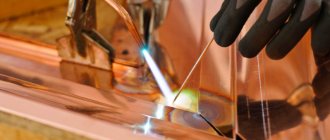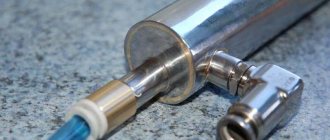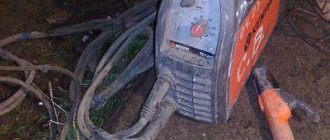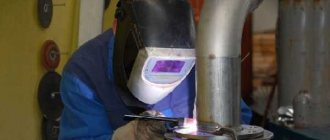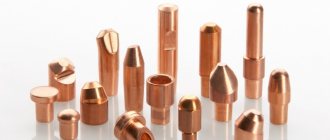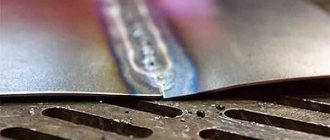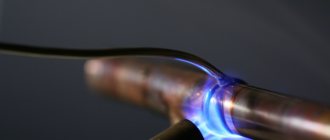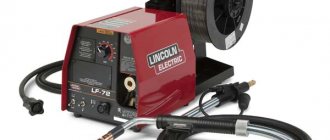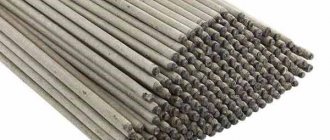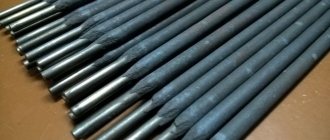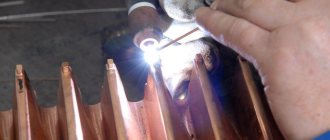List of popular manufacturers
ESAB and the electrodes it produces have proven themselves to be the best. They are used all over the world. The Swedish company ESAB was founded in 1904. It specializes in the manufacture of welding machines of various modifications for one purpose or another. The company has also been able to develop many modern welding techniques that meet modern requirements.
ZELLER is another organization from Germany that has been operating since 1963. It presents a catalog of more than 500 products on the market. All meet high requirements, have good corrosion resistance and form a reliable seam.
Disadvantages and advantages of welding
Among the advantages of using non-consumable electrodes for arc welding are:
- Minimal deformation in metals after welding due to the minimal heating zone.
- High quality connection.
- Speed of work completion.
- Low barrier to entry.
- Availability of a wide range of materials for welding work.
The disadvantages include:
- Shielding gas is blown out of the welding zone, which makes it difficult to work outdoors in windy weather.
- Before carrying out welding work, high-quality preparation of the metal is required.
- Parts must be cleaned when igniting outside the welding zone.
Rod material
The rods that are installed in electrodes and intended for copper alloys are made from rods and wire. Their composition complies with GOST. These are mainly bronze and copper. Metal alloys are often used in manufacturing. Copper rods are made in diameter from 2 to 6 mm. They can be wrapped in 0.3 mm thick sheet metal. They have different coatings applied to them. It can be rutile or basic.
For Komsomolets-100 electrodes, the rod is made of M1 copper. Bronze products are made from a special metal and coated with a mixture of various substances. Sometimes they are made from tin-phosphorus bronze. The bronze rod gives excellent quality to the seams. They oxidize metals less than copper ones. Bronze rods reduce mechanical strength under certain conditions.
Graphite electrodes normal power RP
| units change | ∅ 75-130 mm | ∅ 150-255 mm | ∅ 250-300 mm | ∅ 350-550 mm | ||||||
| FZ | OS | FZ | OS | FZ | OS | FZ | OS | |||
| Resistivity | Electrode | μΩ M | 7,20 | 8,50 |10,00 | 7,50 | 9,00| 10,50 | 7,80 | 9,00| 10,50 | 8,00 | 9,00| 10,50 |
| Nipple | 6,00 | 8,50 | 6,50 | 8,50 | 6,80 | 8,50 | 6,80 | 8,50 | ||
| Tensile strength | Electrode | MPa | 10,50 | 9,80 | 10,80 | 9,80 | 8,40 | 7,80 | 8,40 | 6,40 |
| Nipple | 13,50 | 13,00 | 13,50 | 13,00 | 13,50 | 13,00 | 13,50 | 13,00 | ||
| Elastic modulus | Electrode | Gpa | 9,30 | 9,30 | 9,30 | 9,30 | 9,30 | 9,30 | 9,30 | 9,30 |
| Nipple | 14,00 | 14,00 | 14,00 | 14,00 | 14,00 | 14,00 | 14,00 | 14,00 | ||
| Ash content | Electrode | % | 0,30 | 0,30 | 0,30 | 0,30 | 0,30 | 0,30 | 0,30 | 0,30 |
| Nipple | 0,30 | 0,30 | 0,30 | 0,30 | 0,30 | 0,30 | 0,30 | 0,30 | ||
| Bulk Density | Electrode | g/cm3 | 1,60 | 1,58 | 1,55 | 1,52 | 1,55 | 1,50 | 1,55 | 1,50 |
| Nipple | 1,72 | 1,63 | 1,72 | 1,63 | 1,72 | 1,70 | 1,72 | 1,70 | ||
| (CTE) | Electrode | 10–6/ °C | 2,80 | 2,90 | 2,80 | 2,90 | 2,80 | 2,90 | 2,80 | 2,90 |
| Nipple | 2,80 | 2,70 | 2,70 | 2,70 | 2,70 | 2,80 | 2,70 | 2,80 |
What electrodes are used for underwater welding
Key Welding Principles
When carrying out welding work on copper and its alloys, the welder faces certain difficulties. A crack may form at the seam. During operation, low-melting compounds accumulate at the crystal boundaries. Accordingly, pores are formed. This must be taken into account and prevented. Copper with a thickness of up to 4 mm is connected without cutting edges, up to 10 mm - with one-sided cutting. The bevel of the edges should have an angle of no more than 70 degrees.
Bluntness of 1.5 to 3 mm is allowed. Fluidity significantly complicates work in the ceiling, horizontal and vertical positions. Arc welding is performed at increased welding current due to the high thermal conductivity of the metal. The edges are connected with minimal clearance due to the high fluidity of copper. It is often recommended to use a steel backing.
Products thicker than 6 mm must be heated to 250 degrees. Do this in advance, taking into account the melting characteristics of the metal and the characteristics of the alloys. Thin metal should not be heated. It is better to perform such welding with an arc of 10 to 15 mm. This makes the electrode much easier to manipulate.
With direct current of reverse polarity, copper is welded. This also needs to be taken into account. Arc welding of brass and bronze is performed with a powerful arc. This occurs at increased voltage due to the corresponding current strength. The work is done quickly and at high speed. If possible, it is recommended to do welding in the lower position, as well as at an angle of 20 degrees relative to the vertical.
The arc is directed to the surface of the weld pool. It is better to use special linings. They are made from graphite and asbestos. The characteristics of the metal must be taken into account. Copper melts at plus 1080 degrees. Its strength is 20 kg per square millimeter. If the product is thick, it must be processed gradually. One layer after another is filled.
Welding is performed using a reverse-step seam. The length of each section is from 20 to 30 cm. It is divided into two parts: in a ratio of 75% and 25%. A long area is processed towards a smaller one. This reduces the risk of cracks occurring. The work is done from below. The seam is straightened with a sledgehammer or hammer due to foaming. During the welding process, it is necessary to reduce the current, since heating thin copper can lead to burns. Before starting work, the electrodes are calcined at the temperature recommended by the manufacturer.
What electrodes can be used to connect copper cables
As a rule, not all electrodes are suitable for connecting copper wires. In this case, carbon and graphite electrodes are used. In everyday conditions, when doing welding work with your own hands, such electrodes may well be:
- commutator motor brushes;
- battery cores;
- other similar instruments made of graphite.
Graphite rods are an excellent alternative to factory electrodes, but they are not copper-plated, so the conductor holder must be upgraded when using them.
To slightly adjust the holder for graphite rods, you need to adapt a similar “crocodile”, which is used for electrodes, to connect the mass. They will be more compact than factory ones, and accordingly, working in electrical panels will be much more comfortable. You must also not forget about the additional insulation of the handles themselves. Carbon and graphite electrodes have a common similarity: their melting point is much higher than the melting point of pure copper by four times, as a result of which the consumption of electrodes is quite small.
You need to pay attention! Electrodes for welding copper wires heat up to maximum temperatures instantly, as a result of which there is a risk of overheating of the material being joined, and this can contribute to damage to the insulation of the copper cable.
The welder must take these points into account when working with electrical wiring.
Selecting the electrode diameter
When choosing the appropriate electrode diameter, you need to pay attention to the thickness of the material or alloy based on it.
It is also taken into account that pores may appear in the structure when welding at high currents. Experts recommend choosing this diameter for a certain thickness of copper and alloys based on it. There are electrodes that are used for surfacing and welding with advance heating to 300 degrees Celsius. There is also a small heating from 150 degrees. It is possible to do all this without heating. For copper, manual welding with carbon or metal electrodes, or argon arc welding can be used. Welding non-ferrous metals can differ significantly from a similar process for steel, due to different physical properties of the materials.
The main factors influencing the weldability of non-ferrous metals are boiling and melting points.
Thermal conductivity and susceptibility to air gases such as oxygen and nitrogen are also important. Copper has increased fluidity in molten form and is characterized by increased thermal and electrical conductivity. Microcracks and pores may form during welding if there is interaction with oxygen and hydrogen. To prevent such a defect, it is necessary to use only well-deoxidized metal.
Do-it-yourself copper welding is carried out with well-heated electrodes. Parts must be prepared at the suture sites. This requires cleaning to a metallic shine and removing dirt and grease.
Application of tungsten electrodes
Electrodes for welding cast iron
Carbon and graphite rods are practically not used today for home use. Tungsten rods are used to weld non-ferrous metals, aluminum and stainless steel.
Depending on the welding mode in shielding gases, which is determined by such factors as the thickness of the metal, its type, protective atmosphere and others, the type of tungsten rod is selected for use in the appropriate mode.
Classification of tungsten electrodes of foreign production.
| Current welding mode | The purpose of the electrode depending on the type of metal | Electrode color designation | Electrode brand designation |
| Variable | For welding aluminum, magnesium and their alloys | Green | W.P. |
| Constant | For welding low alloy, carbon and stainless steels | Red | WT-20 |
| Constant or variable | For welding steel of any grade | Gray | WC-20 |
| Constant or variable | For welding stainless and alloy steel | Golden | WL-15 |
| Constant or variable | For welding stainless steels | Blue | WL-20 |
| Constant | For welding stainless, carbon and low alloy steel and copper | Dark blue | WY-20 |
| Variable | For welding aluminum and magnesium | White | WZ-8 |
Refractory electrodes of domestic production are marked:
- EVL - lanthanum rods.
- EVI - yttrium rods.
- EHF - tungsten rods. Welding is carried out only on alternating current.
For EVL and EVI markings, welding can be carried out in two modes with the required polarity. They have different color codes depending on the purpose of use. The choice of mode and current depends on the characteristics of the workpiece and metal. For example, copper and stainless steel products are welded using direct current, while aluminum is welded using alternating current.
When welding with non-consumable electrodes, the polarity should be set: direct or reverse. For reverse polarity, set the ground to minus and the holder to positive, and for direct polarity, vice versa. The shape of the welded metal will depend on the choice of polarity mode. The seam will be deep and narrow when direct current and straight polarity are installed. A wide and shallow seam will be obtained by choosing direct current and reverse polarity.
Tungsten rods tend to become dull as welding work progresses and require sharpening. When the electrode length is up to three diameters, the sharpening angle should be maintained at 30 degrees and the tip should be dulled by half a millimeter. To save the length of the tungsten rod, welding work begins by supplying gas and then igniting the arc. For the same purpose, it is strictly forbidden to knock on the workpieces with the tip of the electrode. The arc should be struck on graphite and then transferred to the welding site.
Working with aluminum
Carbon electrodes are used to connect even aluminum products, which are traditionally considered difficult to weld. Aluminum has low density, significant thermal conductivity and resistance to corrosion.
This metal melts at a temperature of 660 °C, and it combines quite well with oxygen, which is why it is covered with a film of aluminum oxide (chemical formula - Al2O3).
The presence of such a film, as well as the ease of formation of cracks and pores in the weld metal, are the main difficulties encountered when doing this. But the use of carbon electrodes makes it possible to cope with them.
In particular, this is the method used to connect aluminum busbars in electrolysis shops. Tires are traditionally butt welded on a graphite or aluminum backing.
Graphite plates with cutouts opposite the seam are mounted on the sides of the tires. These cutouts make it possible to move the end and start points of the seam beyond the boundaries of the working section.
When welding aluminum surfaces using carbon arc welding, the filler material is wire or rod made of the same metal. To ensure that the oxide film does not interfere and does not affect the result, AF-4A flux, which is a homogeneous, fine white powder, is added to the edges of the seam.
Types of carbon electrodes
The regulatory framework for the production of domestic carbon electrodes is GOST 10720-75, which contains a description of three types of such products: VDK, VDP, SK, which can be produced either copper-plated or uncoated. Air-arc round air-arcs should be manufactured with a length of 300 mm and four standard sizes in diameter. SK (welding round) - 250 mm long and six standard sizes in diameter. VAF (air-arc flat) - 350 mm long and two sections. At the customer's request, it is allowed to manufacture SK products with a linear dimension of up to 700 mm.
In addition to domestic electrodes, the Russian market offers products from well-known international welding brands and manufacturers from East Asia. The Swedish concern ESAB offers over twenty types of copper-plated carbon electrodes. In addition to products used for direct polarity direct current welding, the ESAB range includes four standard sizes for alternating current welding
And the well-known German manufacturer of welding accessories ABICOR BINZEL, when advertising its products, focuses on the fact that it is made of “synthetic graphite” (i.e.
graphitized carbon). It is likely that these products were pressed from powder obtained from the remains and scrap of metallurgical graphite electrodes.
As a rule, they are rectangular rods with a thickness of 10, 20, 30 or more millimeters and are used for large-scale work at high welding currents: cutting metallurgical scrap, eliminating profits on castings, through cutting of thick metal, etc.
Heating Methods
There are several ways to heat consumables. The following devices are most often used at home:
- Soldering iron. Used to perform work characterized by relatively low temperatures. The maximum impact does not exceed 400 Cº. Modern models are equipped with a mechanism for adjusting the temperature. They produce battery-powered soldering irons. Ideal for working with gold and other soft metals.
- Burner. There are gas and plasma models. They use one type of fuel - natural gas, and differ only in the size of the flame. They operate at high temperatures, which makes it possible to solder refractory metals. The disadvantage of burners is the difficulty of adjusting the flame temperature.
